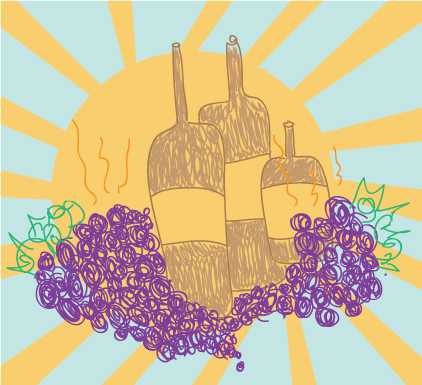Wine industry can’t take heat

Rising temperatures and sea levels could cause major setbacks to the wine industry
May 12, 2014
Climate change is reportedly depleting the nation’s coastlines, but land is not the only thing affected —the wine industry is also baking in the sun.
Rising global temperatures are expected to have negative economic effects on the wine industry. Jim Harbertson, associate professor of enology at Washington State University, said consumers may have to deal with inflated wine prices, and the overall quality may diminish in coming years, forcing wineries to develop improved marketing strategies to remain globally competitive.
Harbertson said climate is the most important aspect of viticulture—the cultivation and science of vineyard grapes—because the amount of sunlight grape vines receive is critical to their development. Grape vines produce their sugar with the sunshine on the leaves consumed through photosynthesis, which contributes to the aroma, color and pigments in the wine grapes, Harbertson said.
“All of those things are tied to the climate, so you can begin to understand how important those things are in terms of just getting good fruit and high quality fruit,” Harbertson said. “It’s a really delicate balance to be in.”
Increased changes in temperature are throwing off grape vine growing patterns. According to a March 31 report from the United Nations Intergovernmental Panel on Climate Change, rising temperatures threaten to affect water supplies and resources, which would in turn negatively affect wine grape growth because they are heavily dependent on water.
Dan Cayan, climate researcher at the Scripps Institution of Oceanography and the United States Geological Survey, said sea levels are rising globally because of temperature increases in northern ocean waters and in water masses in ocean basins near the coasts. This flooding could eliminate the coastal land currently used for viticulture.
“One thing that geomorphologists will emphasize is the fact that the [coasts] are real dynamic places,” Cayan said. “We’re not just talking about a bathtub where the edges are static. The coasts are changing.”
According to Joseph Kelley, a marine geology professor at the University of Maine, Earth’s sea levels are out of balance. While sea levels are rising in some parts of the world, they are falling in others, he said. However, tide gauge records, which are affected by land level movements and strong ocean currents, suggest that sea levels are rising at a rate of approximately 1.5–2 millimeters per year since the first records in 1900, which may cost the U.S. valuable agricultural land on its coasts.
The report indicated that residents are moving farther inland because of vanishing coastlines, where most wineries sit. Kelley said he does not think cities and vineyards will be completely abandoned because of their enormous value, but bigger walls will have to be built and pumping systems will have to be maintained, he said.
Climate change is believed to be the cause of increasingly severe storms, floods and droughts, according to the United Nations report. Harbertson said California has an extreme water shortage, and because the state is so heavily populated, more water is required to accommodate residents’ everyday needs. He said California, a major agricultural state, and its wine industry are suffering as a result.
Harbertson said growing grapes requires 1,000 liters of water. Another 10–100 liters are needed in the winery to produce 1 liter of wine, which is equivalent to filling up a bathtub.
“If you’re not getting water from a natural resource, you’re having to buy it,” Harbertson said. “It stops making sense. It stops being a simple arrangement where there’s a natural balance between things and resources that we can utilize quickly, easily and sustainably.”
As a result, the wine industry has to adjust its growing and production techniques to adapt to the effects of climate change. Harbertson said wineries will need to innovate and start using technologies that use less water more efficiently. One process wineries can adopt is the clean-in-place method, in which less water is used to clean more tanks because the same water is reused, similar to the way dishwashers function, Harbertson said.
“You’re lowering the amount of water [used], making it more sustainable,” Harbertson said. “They’re not going to change what they’re doing until there’s really a financial pinch.”







